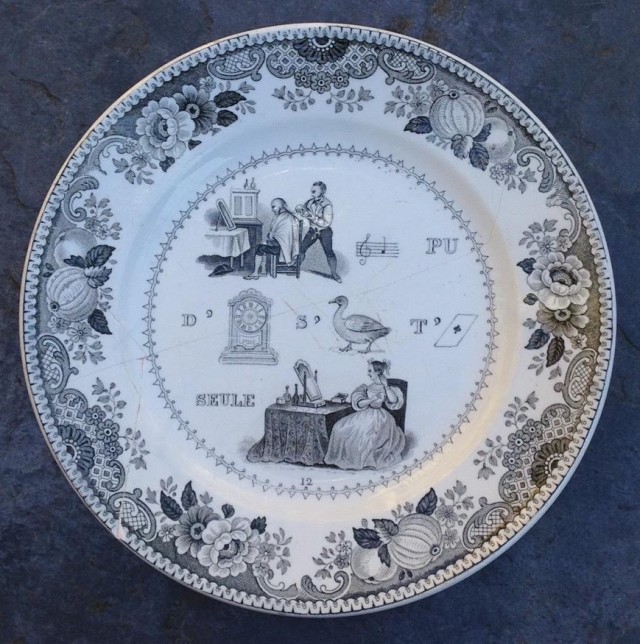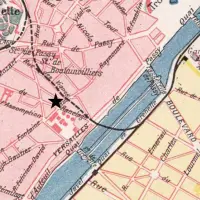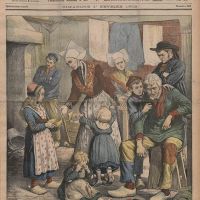I took my umbrella to Paris in March. It was not that I needed it to keep off the rain. It was so that I could do something with it in Paris I could not do in Canada: get it repaired.
I bought the umbrella some years ago in Montreal, and about the third time I used it, a gust of wind turned it inside out and snapped one of the struts. I couldn’t find anyone to repair it in Toronto (or indeed, anywhere in Canada), but I kept it because I liked the fabric and the colours. I hated the idea of simply throwing it away because a strut was broken. And then I realized that in Paris, one can have such things repaired.
My online searching yielded two addresses for repair shops: one in the 3rd and one in the 12th. The day after our arrival, I headed for Pep’s in the 3rd. I had read about it online, and as usual there were crabby comments about someone having arrived to find the place closed. I wasn’t sure my plan would work.
Pep’s is in the Passage de l’Ancre Royale, just off the rue de Turbigo. It’s a different world in there, and one can forget the 21st century outside.
A sign indicated to ring the bell. There is only one employee, and he works upstairs. (Perhaps the crabby person who commented online had not seen the sign?)
The repairman responded promptly and opened the door. I handed him my umbrella. He took a look, asked for 22 euros in advance, and told me to come back the following week. When I came back to pick it up, I could not even determine which strut had been repaired. Can you?
The repairman’s name was Thierry Millet. He told us he has worked in the shop for 14 years, but the shop itself has been there for more than 40 years. The card he gave us indicates that it is an “Entreprise du Patrimoine Vivant,” which means that umbrella creation (Thierry makes umbrellas as well) and repair is considered part of France’s living national heritage. I find that reassuring.
Our second recourse to a Paris artisan during our holiday came after a visit to a brocante (antiques fair). We love brocantes. If you Google “brocante paris” plus the date (such as “avril 2016”), you can find out when and where these events will be held.
The website vide-greniers.org directed us to the rue Cler in the 7th on a Sunday afternoon. It was the usual hodgepodge of genuine antiques, secondhand bric-a-brac, and garage-sale rejects that offers the promise of something unexpected if you just take the time to hunt a bit. And there is always a still life worth photographing, if only for the interesting reflections.
After a while I spotted four plates, each of which was decorated with a rebus (a motto or saying spelled out with pictures and letters). Five euros each. And for 20 euros, the stall owner threw in a rather nice ceramic tile Norman found.
I particularly liked one plate, perhaps because I was able to make sense of its rebus more easily than those on the other three. The stall owner wrapped the four in bubble wrap and I put the package in one of those folding nylon bags that I keep in my purse. But a little while later, as I was fumbling for my Navigo card, I dropped the bag on the sidewalk.
I went to the nearest stall to open the bag and check the damage. And yes, my favourite plate had broken into six pieces. The nearby stall owner came over to take a look. “We call that the devil taking his part,” she said, sympathetically.
I was dreadfully disappointed and out of sorts. I felt just the way I had when my umbrella broke so soon after I had acquired it. What to do? My first reaction was to photograph the rebus and throw the pieces away. But then I realized that this is Paris. I could have it repaired. Norman even offered to try repairing it himself. That settled the matter. I would get a professional on the job.
Back at our apartment, I went on line and searched for “Paris réparation céramique.” I identified two potential china repair shops. One was open on Mondays, so I called there first. Sophie Jehan of Atelier Cerami’K told me to come by on Tuesday. Her workshop was in the 11th, just off the rue de Charonne.
Sophie took a close look at the pieces and asked me if I wanted it to be repaired so the breakage was completely invisible, or if I just wanted it put back together again. I chose the second option. Okay, 30 euros, come back on Friday. Perhaps an excessive investment in an elderly piece of china, but I was getting into the spirit of Make Do and Mend, and I agreed.
Here is the plate after the repair. You can see the cracks, but it is neatly mended. I wasn’t planning to eat off the plate or put it in a dishwasher. It will likely hang on the wall.
(If you would like to see the other plates – from an original set of at least 12 – scroll down and try your luck at interpreting the rebuses. The solution to the one above is also at the bottom of the blog.)
All in all, I was very happy to have the plate restored to me in one piece.
Our third exposure to the ethic of Make Do and Mend (albeit on a completely different scale) came at the Musée du Compagnonnage, which a good friend of ours had recommended. It’s a tiny two-room museum near the Place St-Sulpice (there is a much larger museum devoted to the same subject in Tours).
The word compagnonnage can mean either a guild or an apprenticeship. France’s surviving guilds are all related to the trades of construction and repair of buildings, although the country once had guilds for artisans making everything from sabots (wooden shoes) to carriages.
The museum displays scale models of a range of building elements. Each apprentice must produce a masterwork to demonstrate his skills and these are some of the results. The quality of work and the detail is astonishing.
The man who showed us around, Yves Lapellegerie, was a retired carpenter in his eighties, and one of his own constructions was on display. Yves had created the wooden ribbing for a four-sided series of roofs, each one a different shape: straight, Empire, domed, and Mansard, surmounted by spires and knobs. He did it when he was 20, he said, and working at a full-time job, so it was all done in evenings and on weekends. It took him years.
Yves told us that some people keep offering to buy these masterworks, and it is understandable. But they are without price.
The compagnonnage system still supports young people who want to develop skills in a trade, and makes arrangements for them to work in different parts of France to experience the range of regional cultures and traditions. Yves described this process as allowing for “l’ouverture de l’esprit” – a lovely expression.
All kinds of building trades are included, such as serrurerie – the creation or repair of metal locks, grills, enclosures, or awnings (marquises) – or the art of making and repairing roofs – slate, pantile, zinc, copper – on new and heritage buildings.
As we walk through Paris, it is rare for us not to pass a workshop in which someone is carrying out repairs – to watches, jewellery, musical instruments, furniture, metalwork, shoes, or clothing. To be sure, the garbage cans still overflow with broken umbrellas and cracked china, but in Paris, at least one has the choice whether or not to throw things away or repair them for a longer life.
Text by Philippa Campsie; photographs by Philippa Campsie and Norman Ball.
1.The rebus for the repaired plate shown above reads: Que la pudeur soit ta seule parure. Solving the puzzle involves assembling the words for each image and saying them aloud. In this case: QUEUE LA (musical note) pu d’HEURE s’OIE t’AS seule PARURE. (Let modesty be your only finery.) It’s a bit like Fractured French.
2. The plate above represents: Les méchants sont méprisés de tous. (Nasty people are despised by all.) I found this one hard to figure out, and would appreciate readers’ thoughts on the interpretation.
3. This one spells out: On voit par fois battre en retraite sans tambour ni trompette. (Sometimes one sees a retreat without fanfare.)
4. This one means: Un service reçu ne doit pas s’oublier. (A favour received should not be forgotten.) What is the last image showing? Any ideas?



































Lovely post. By taking things for repair you were keeping up demand for those services. That, too, is missing in the U.S.’s throw-away culture, and probably in Canada too.
Make do and mend.
This is very much the attitude of our Victorian grandparents and in fact our own parents (or one of mine) who simply could not throw something out if it could be mended. But there is a huge difference between the invisible mending of the umbrella or the excellent repair of that lovely plate and some of the china butchery I’ve seen in my trawls through relatives’ cupboards. Riveting plates, popular with my English forebears, baffles me although I suppose it kept a set ‘intact’ – after a fashion. But when recently going through some old family china for dispersal (disposal) I came across teapot spouts mended with blu tack which had hardened and then been painted in as close a (mis) match to the pattern as possible. Not only were they useless, they were ugly.
Your French restoration connections would have been appalled by what I found. I heartily approve of make do and mend, but it has to be done sympathetically and professionally as yours were, so the items still give pleasure and are cosmetically appealing even if sometimes the usefulness is limited to decoration only. I have had to bin umbrellas that I now wish I’d taken to Paris to be mended. A wonderful old black Victorian one of my husband’s grandfather comes to mind: its sterling silver inlaid decoration on the beautiful wooden handle made it a work of art but after trying unsuccessfully to find someone in London (England) to do the work (this was thirty years ago, and I’m sure with the internet I would have had more success now), we regretfully consigned it to the bin.
I’m delighted that your umbrella and plate can live to fight another day.
You’re right. The Internet does make a difference in our ability to find the people we need. As for homemade repairs, I suppose for some people it was the only option at the time. It looked awful, but it extended the life of the object for someone who couldn’t just pop out and buy a replacement.
Have you been Aux Arts et Sciences Réunis? It’s the cantine of the carpenters and masons guilds but also a restaurant open to the public, so whenever we’ve been there have been apprentices, journeymen and master carpenters dining there. There is also a museum attached, full of chef d’oeuvres, some of them huge. One evening we were invited to see it because the restaurant was quiet. It’s in the 19th on Avenue Jean-Jaures. Routard describes the place as “heroic defenders of the arts of stone, wood and…the dining table”. We’ve been to the museum in Tours which is full of intriguing objects.
We haven’t…yet, but Yves told us about it. It is particularly the enormous chef d’oeuvres in the museum there that people want to buy. Well, next time.
Your piece inspires me to find these places while I am still here. Preserving the patrimoine is what makes France such a wonderful place to be at home, right here, for a month.
Lucky you! Enjoy your stay.
It seems there are still plenty of people in Paris prepared to pay for repair services. I was in Pep’s recently when someone asked hopefully about same day repair for her umbrella. She was shown a large pile of neatly labelled umbrellas awaiting repairs and was told hers would have to join the end of the queue. Thanks for an interesting read – the rebus plates were completely new to me.
Important…allow enough time for repairs. Nothing happens immediately.
A lovely post, and certainly whetted the appetite for the next visit to Paris. I am always delighted to find people who repair with such care – it’s something I’ve noticed in various places, from France to Japan, and I wonder if it is something to do with the way an old culture caretakes its past (because it’s not something I come across in my ‘new country’ Australia, and you don’t in Canada, either).
I do think it has a lot to do with growing up surrounded by older objects that require some care.
Isn’t it great when you can find people who will do a great, quality repair for the things you love?
And isn’t is great when nice people like you will share what they know so that other people can be happy too?
Marilyn
And isn’t it great when people write to tell you that they appreciate what you do? Thank you so much.
I love this. Repair cafés are sprouting up as well (a Dutch idea) where people with time/knowhow/tools help folks who want to fix their stuff.
And I adore your plates. I’m going to keep my eyes peeled as vide grénier seasons picks up.
Happy hunting!
Bonjour Philippa – Actually, the Umbrella Shop in Vancouver repairs umbrellas, so the next time an umbrella breaks, come for a visit. The folks at the U. Shop think they are the only umbrella repair shop in North America. But Vancouver is not Paris, bien évidemment. And thanks for the tip about the compagnonnage museum – we love these little museums off the beaten track.
One more thing on umbrellas. Last year I saw an incredible umbrella store in Paris in the arcade shops under the Promenade Plantée, La Parasolerie Heurtaut: http://www.parasolerieheurtault.com/fr/accueil/index2 . But the nec plus ultra of Parisian umbrella shops must be this one, on the Blvd. St. Germain: http://www.alexandrasojfer.com/ . Watch their scrolling umbrella art on their home page. Only in France…
And in the last one, could the little boy be buying cookies called “oublies”? The one I do not understand is the first image on the third plate: “voit”. Why the man with two pots is called “voit”? I find also funny on this image that “fois” comes from “fouet”; it gives us some clue on the accent behind the plates.
Hello! Maybe the little boy on the last plate is playing a game we in Portugal call the “Vermelhinha” where someone has three small cups, one of the cups has a little piece inside ans it goes around and around. Maybe the boy cannot “oublié” where the piece is. Thanks for showing me other sides of Paris.
I think you are right. It looks like that game. I cannot find a specific translation of Vermelhinha, other than a generalized “card trick/tour de cartes,” but it is the most plausible solution. Thank you very much.
This was such an interesting post. I began reading because I once stayed in an apartment in the Passage de l’Ancre, and when I discovered Pep’s was a neighbour, I had him make me an umbrella, which I still use. I was really fascinated by the rebus plates, and the puzzle of them. Thanks for telling us about them.
That must have been a very interesting apartment in the Passage de l’Ancre. It’s a fascinating part of the city. What does your umbrella look like?
It’s a dark red tartan pattern. I chose the fabric from his selection. I found the apartment online (6 years ago) and it was arty and beautiful, but it was on ground level, consequently the only windows looked out onto the passage. To see the sky (or the weather) I had to go out into the street. The gates at each end of the passage were locked at night, so I felt very secure.